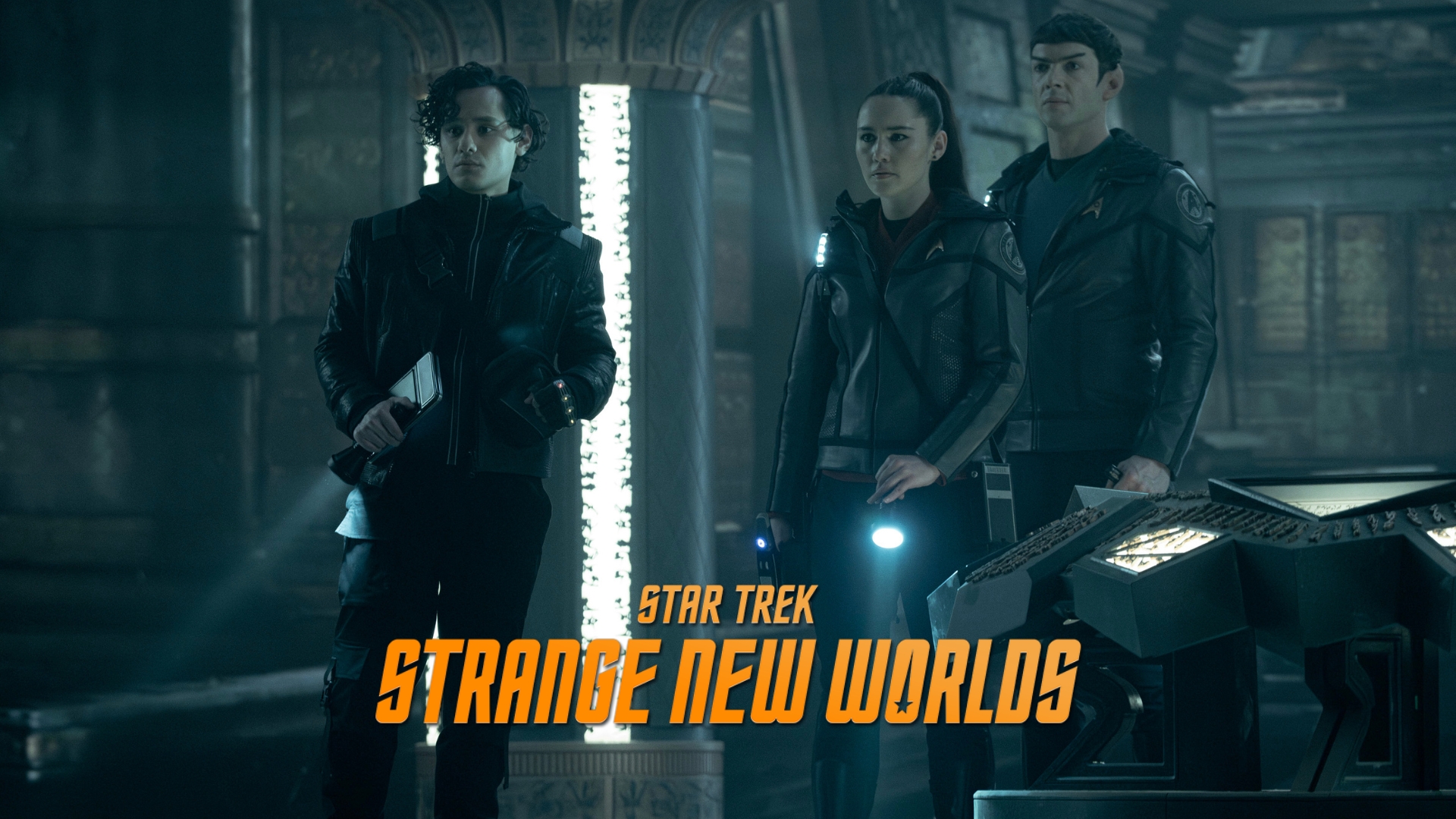'Through The Lens of Time' Offers a Window Into a More Interesting TV Show

"Through the Lens of Time" is, perhaps, symptomatic of how there is something endemic affecting Strange New Worlds episodes.
There is everything here that should make a good episode: strong character work, a mystery, proper TOS-style science fiction horror, a mad-house prison for the most dangerous entities in the galaxy…and yet the writers don’t seem to understand what the interesting part of the story is. They’re getting close! But they don’t seem to know - and then they get really excited about getting two possessed characters to beat each other up and then killing off the, uh, black kid who has just had his eyes burned away, Bad! Very Bad!
We open with Nurse Ensign Gamble’s log, as Roger Korby sets out to “change history”. With Enterprise on station over Ma’krun, the archaeological team is setting out to explore a delicate, protected site. Korby is nervous (to the point of being an asshole), and Chapel is nervous about Spock (to the point of being awkward). It is a little soapy listening to La’an and Chapel talk about Spock, of all people. Which, generally, I am not a fan of. Listen, I am a big fan of Science Fiction mysteries, and yet "Through the Lens of Time" seems to love the soapy elements between Spock and Chapel and the weirdness of Pelia flirting with Umberto Ortegas, who is here to film a documentary in the most amateur fashion possible? I guess?
Planetside, we meet Korby and N’jal, the local guide. With the aid of Enterprise’s deflectors (and Umberto's Flirting?), the away team discovers an ancient temple, with Spock and La’an beaming down to assist. The crew speculates about what they could find: ancient astronauts? Royalty? Immortality? A little pin-prick from Chapel at the doorway and a fancy scan gets the gang into the chamber! The chamber also has a group of dead graverobbers, which then picks off the first of many arguments between Spock’s Scientific protocol and Korby’s archaeological assertions, mediated by Chapel and some, uh, slightly hokey wisdom from N’jal. Things then escalate quickly when Ensign Gamble gets blown up by a glowing alien device, which, uh, gouges his eyes out.
With the kid screaming in pain, Pike orders the team back to the ship. Korby wants to stay, obviously, to explore the register of names and assets the team discovers, but when Umberto sends his drone through to the second chamber, N’jal panics, runs, and gets vaporised by the temple door, trapping everyone inside the chamber-that-looks-like-a-borg-cube-made-of-marble. With few options, the gang decides to search for clues in the other chamber. Except, of course, they get split up Scooby Doo style.
From this point on, the plot descends into a reasonably typical science fiction mystery tomb plot - the sort of thing that would be rather compelling on, like, Stargate. Yet here, when the mystery and its twists aren’t actually that interesting, it ends up just being a kind of dud space in the plot, where we watch six actors bumble about in the poorly lit AR void for five minutes at a time. As before, the B-Plot - M’Benga and Gamble’s injuries - is much more interesting, both as an emotional story and also because of the slightly sinister air Gamble has when he’s injured. Well, actually, he’s technically brain dead (news to the Ensign), but those scenes are much more interesting than watching Chapel and La’an talk technobabble over a panel of Chinese characters and a (let me check my notes) quantamly-unstable semi-alive statue. There’s some more interesting stuff, eventually, and although the writers refuse to really engage with Spock and Korby’s intellectual argument over immortality, they do eventually kick the plot into gear when Spock finds a way to see into the well, which is full of golden orbs that contain terrible beats: evil! Evils, probably!
This thread is not helped when Pike is briefed on the device, which Scotty and Pelia identify as a containment device for something ancient. Said ancient thing is, of course, now inside of Gamble, taunting M’Benga about his daughter when it then jumps an equally possessed Captain Batel, leading to an extremely violent fight across sickbay before the Security team shows up. To which my main response is… for the love of god. It’s interesting in the sense that there’s an interesting plot going on here under the hood. It would be really cool if the writers just told us what the hell was going on, instead of letting us speculate about why Gamble and Batel are now having some ancient eldritch horror deathmatch. I feel bad telling people to “tell, not show”, but they’re barely even telling right now.
The planet plot does resolve itself, revealing that the complex is a prison placed across multiple layers of reality (joy), but it is still laboured. There is a sense in which this reveal would have probably landed better before the Batel-Gamble fight in some way. Or, at the very least, earlier in the episode. The section where Chapel coordinates the reality-realignment is quite good: actually, this is generally a rather good Chapel episode by virtue of the fact that it does a decent job at detaching her as a character from the men in her life.
That should not be a difficult ask in the year of our lord 2025, mind.
Watching Pike and Batel talk through her possession “episode”, where he tells her how he is going to resolve this situation while she sits there and nods without adding anything, you’d think it is a difficult ask: between that and the temple plot resolving itself to “does Chapel trust Spock or Korby more,” it is no wonder that I was more intrigued by (and drawn to) the nature of the beast controlling poor Ensign Gamble, as it manipulates red shirts and savagely breaks its way out of the brig while communicating with spirits? Sure, the music and the writing want us to enjoy the tension of Chapel and La’an stepping onto thin air, but c’mon, guys. It’s Star Trek.
I am much, much more caught by the final confrontation between the being as it tries to seize control of the ship, for two reasons. Firstly, it’s just more interesting. They’re making a habit of the interesting plot being the one they don’t talk about a lot, which I am not a fan of generally, especially here. I feel like Gamble taking over the ship could have been a stronger plot element in act 3, especially if we leaned more and more into the manipulative nature of the creature as it stalks its way to engineering to seize control of the vessel. Compare it with TNG’s "Power Play." There’s more to be done with that crisis than a slow burn mystery. Secondly, I am not a massive fan of the young black man pleading for his life getting shot in the back by a white woman, even if the former is possessed at the time. If Gamble had to die (which…did he?), there had to be a better way than that, surely. Scotty nabbing the beasty and holding it in the transporter buffer was a nice Chekov’s gun, though. I’m sure that’ll come back to haunt us at some point.
So: the beast is “contained,” the crisis over, and we are left with a quantum reality prison of eldritch horrors beyond our comprehension and negotiation. It’s…an ending. It’s certainly an interesting addition to the canon of Trek as a show, and in some senses a natural follow-on from the traditional horror elements of Star Trek. The Original Series, especially in its earliest iterations, was at heart a horror show - just think about "The Man Trap," "Charlie X," and "Where No Man Has Gone Before." It’s nothing new in that sense, and yet there’s something about this run that I don’t like. The conceit that this Vezda being is pure evil: ‘the desire to malign, pervert and consume given corporal form’, as Pelia puts it, is…sort of new? In some senses? We’ve had plenty of close-to-evils before: the apathy of the Talosians, the childlike malice of Nagilum (‘Where Silence Has Lease’), or even the almost disinterested savagery of the Founders. The sheer spirit of evil? I’m not sure.

















